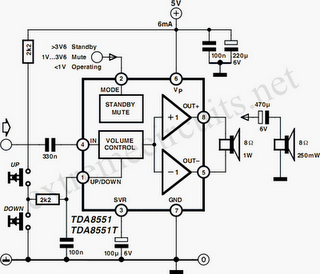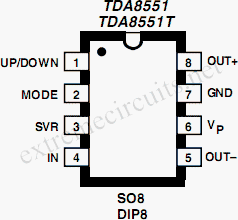Home » Circuits
AF Amplifier With Digital Volume Control Based On TDA8551
The Philips Semiconductors TDA8551 is a small audio amplifier with an integrated volume control. When operated from +5 V, it delivers a nominal output power of more than one watt into 8 ohms. It can also be used over a supply voltage range of +2.7 to +5.5 V, with correspondingly reduced output power. The output volume can be adjusted from –60 dB to +20 dB in 64 steps, using a set of up and down push-buttons. The shared UP/DOWN input for the up and down switches has three states. If it is ‘floating’, which means that both of the switches are open, the volume remains unchanged. A pulse to earth decreases the volume by 1.25 dB, while a positive pulse increases the volume by 1.25 dB. When the power is switched on, the internal counter takes on the –20 dB setting. An additional input (MODE) allows the amplifier to be switched from the operating state to the mute or standby state. If this input is held at the earth level, the amplifier is operational. If +5 V is applied to this pin, the TDA8551 enters the Standby mode, in which the current consumption drops from the typical operational level of 6mA to less than 10µA. Finally, the MODE input can be used as a mute input by applying a voltage of 1 t0 3.6 V to this input. This voltage can be provided by a connection to the SCR pin, which lies at half of the operating voltage and to which a filter capacitor is connected.
When the power is switched on, the internal counter takes on the –20 dB setting. An additional input (MODE) allows the amplifier to be switched from the operating state to the mute or standby state. If this input is held at the earth level, the amplifier is operational. If +5 V is applied to this pin, the TDA8551 enters the Standby mode, in which the current consumption drops from the typical operational level of 6mA to less than 10µA. Finally, the MODE input can be used as a mute input by applying a voltage of 1 t0 3.6 V to this input. This voltage can be provided by a connection to the SCR pin, which lies at half of the operating voltage and to which a filter capacitor is connected.
 The loudspeaker is connected in a floating configuration between the two outputs of the bridge amplifier in the TDA8551. This provides the desired output power level, in spite of the low supply voltage. For headphone applications, which do not need as much output power, you can connect the headphone between earth and one of the outputs, via an electrolytic coupling capacitor. You can make a stereo headphone amplifier in this way, using two TDS8551 ICs. The TDA8551 is housed in a DIP8 package. The SMD version is the TDA8551T, in an SO8 package.
The loudspeaker is connected in a floating configuration between the two outputs of the bridge amplifier in the TDA8551. This provides the desired output power level, in spite of the low supply voltage. For headphone applications, which do not need as much output power, you can connect the headphone between earth and one of the outputs, via an electrolytic coupling capacitor. You can make a stereo headphone amplifier in this way, using two TDS8551 ICs. The TDA8551 is housed in a DIP8 package. The SMD version is the TDA8551T, in an SO8 package.
